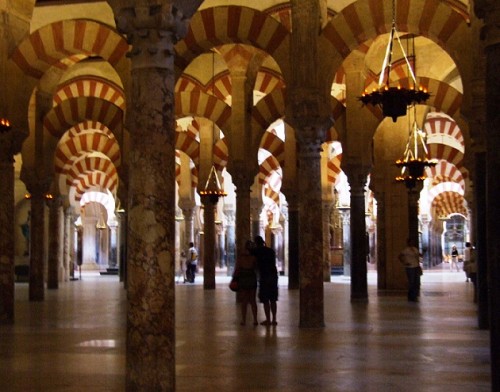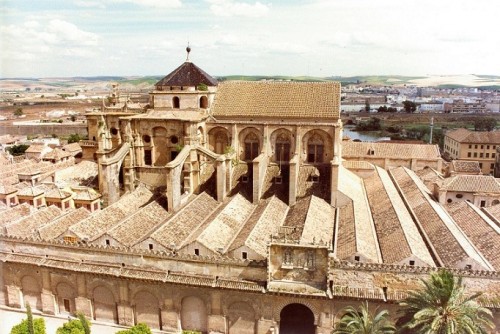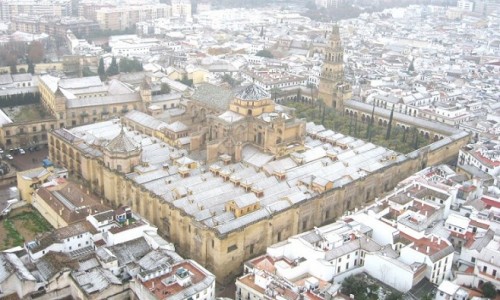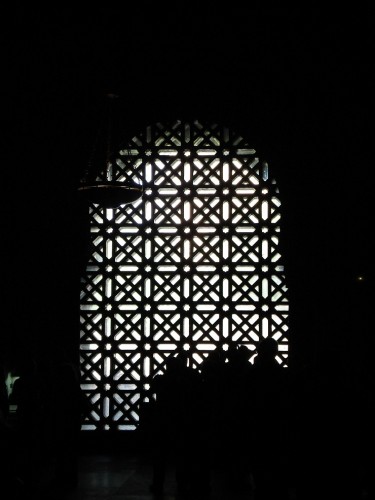[ cross-posted from Zenpundit ]
1.
I think of how the Mezquita, once a mosque, must have looked when its whole floor was a single, arched space of prayer:
before Moorish Cordoba was conquered, and the conquerors built a cathedral in the very heart of the place:
like the petals of a flower opening inside the sepals, or a cancer sprouting within the body for so much depends on your understanding of prayer.
2.
And I think how lovely it still looks, cathedral nestled within mosque under the snow, to this photographer’s eye:
3.
And I think of Seymour Hersh, who has drawn flak for comments in a recent speech about the Bush war in Iraq, and Obama’s continuation of Bush policies and here’s the part that caught my eye:
“In the Cheney shop, the attitude was, ‘What’s this? What are they all worried about, the politicians and the press, they’re all worried about some looting? … Don’t they get it? We’re gonna change mosques into cathedrals. And when we get all the oil, nobody’s gonna give a damn.'”
“That’s the attitude,” he continued. “We’re gonna change mosques into cathedrals. That’s an attitude that pervades, I’m here to say, a large percentage of the Joint Special Operations Command.”
And I think then of the great cathedral of Hagia Sophia in Constantinople, that was conquered and became a mosque:
and is now a museum. So these things go, in times of war.
4.
As for the Mezquita, its history is more complex than I have suggested: it was first a pagan temple, then a Christian church, then shared between Muslims and Christians, then made into a mosque, then a church again and the cathedral as we see it today was built during the Renaissance…
And I think at last how much depends on lofty spaces, and on silence, and on prayer:





This reminded me of an andalusian jewish poet who lived and wrote at the time the Cordoba Mosque was still a mosque. His name was ibn Gabirol, and here´s an extract of one of his poems:
“My impudent foe seeks my life-faith to sever,
To my face he enquires how long yet wilt thou wait,
But I am afflicted, not cast off for ever,
For my God is the help of the low in estate,
Protecting the poor as He humbles the great.”
“His heritage shall to the exile be given,
And a strong hand the sick and the punished replace,
The abased and abandoned, by every fang riven,
Shall their freshness renew by the patriarchs’ grace
And the strangers be scorched like a tropical place.”
Ibn Gabirol, The Redemption.
As they restore Hagia Sophia, they are finding that, under those big calligraphy screens, the craftsmen, who were mostly Christian “converts” did not destroy the Christian mosaics but carefully covered them with straw and clay. The idea must have been that it would be recaptured and the mosaics restored. Most of the great treasures of the “Age of Translation,” under Harun al Rashid and his son, were the work of Christian linguists. A large share of the Muslim treasures from that era were the work of Christians.
When Mehmet II entered Constantinople, amidst the the pandemonium after the defenses were breached, he rode straight to the Hagia Sophia. Some of his troops had begun to vandalize the place. He stopped them saying “the loot is yours but this building is mine.”
I hope that one day the holy sacrifice of the mass will be celebrated there again.
Jose Angel de Monterrey:
How can I resist a poet of whom it is said, “His religious poems now form part of the regular prayer service in Jewish communities throughout the world, and downtown Tel Aviv traffic jams take place on a street that bears his name”?
It seems his writings influenced Duns Scotus, who influenced my own teacher, Hopkins.
Michael:
What a palimpsest we do live in!
Lex:
When the Caliph Omar took Jerusalem, he asked the patriarch Sophronius to show him the city’s holy places. The patriarch took him to the Church of the Holy Sepulchre and invited him to pray, but he refrained, so his followers would not declare the church was now a mosque. He then had the “Mosque of Omar” built across the courtyard from the church.
Saladin converted the church to a mosque for three years, then returned it to Christian use.
As I understand it, the Divine Liturgy is celebrated there daily.
I’ve visited the great mosque in Cordoba – and it is stunning; it’s like walking through an endless forest of tall stone trees.
My daughter lived in Cordoba for a year. She took pictures of the Lenten festival in which hooded family members carry large religious icons, sort of like Rose Parade floats, through the city streets. There was a similar scene in Godfather II but apparently this is a huge thing in Cordoba. The floats are hidden by families the rest of the year and have gold and silver trim on them. Each float is carried by a different family or clan and they have different colored robes and hoods. I’ll find some of her pictures and post them
Charles V. had originally ordered the reconstruction of the Mezquita, but when he saw the result he allegedly commented “You have destroyed something unique to make something commonplace”.
I envy you your visit to Cordoba, Sgt. Mom, and your daughter’s, Michael — I look forward to the photos.
*
Ralf, I had heard that comment and forgotten it. Thank you for reminding me, it will serve a useful purpose in a writing project I am engaged in
It also contains, it seems to me, the seeds of a significant principle in aesthetics — one that dovetails nicely with some remarks I heard Murray Gell-Mann make at CalTech concerning a mathematical approach to beauty as complexity. Under Gell-Mann’s proposal, those works of art — or areas of the rain forest, or older buildings in a city where space to build new high rises was at a premium — which would require the longest computerized description to allow them to be fully reconstituted elsewhere >> would also be the ones humans think of as most beautiful, and thus most deserving of preservation.
The Ummayad Mosque in Damascus was once
The Basilica of St. John which was once
The Temple to Jupiter which was once
The Temple to Hadad
If it was a temple to an unknown god before that remains a mystery.
Thanks for that pointer, John — and it was the first mosque visited by a Pope, eh?
Might I add that as a regular reader of Crossroads Arabia, I’m delighted to find you here.